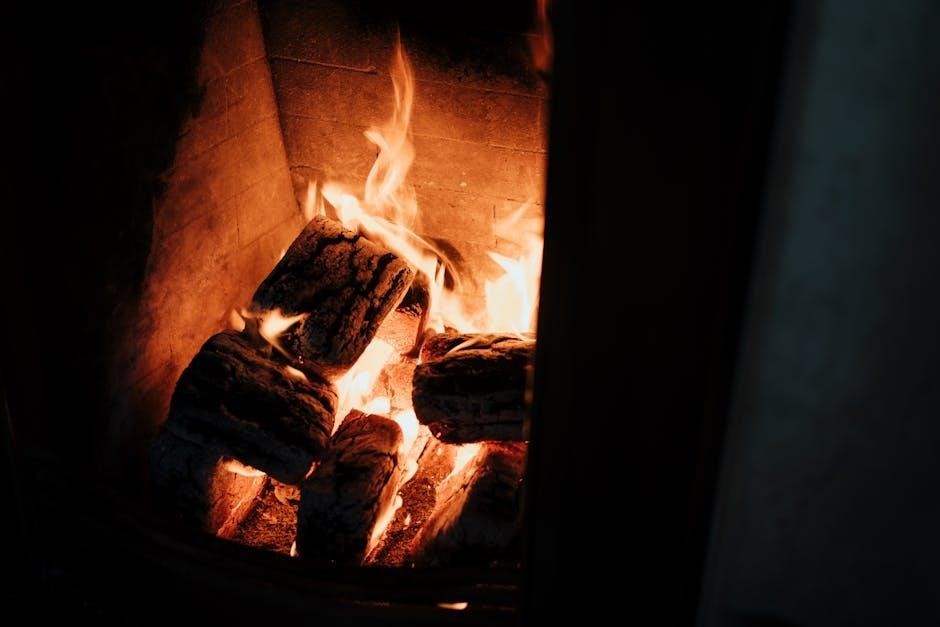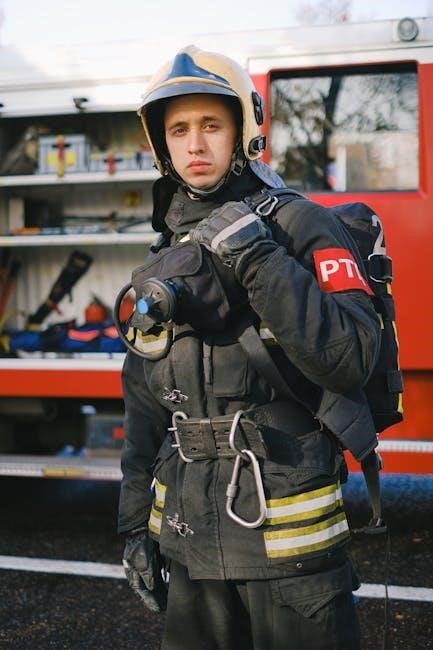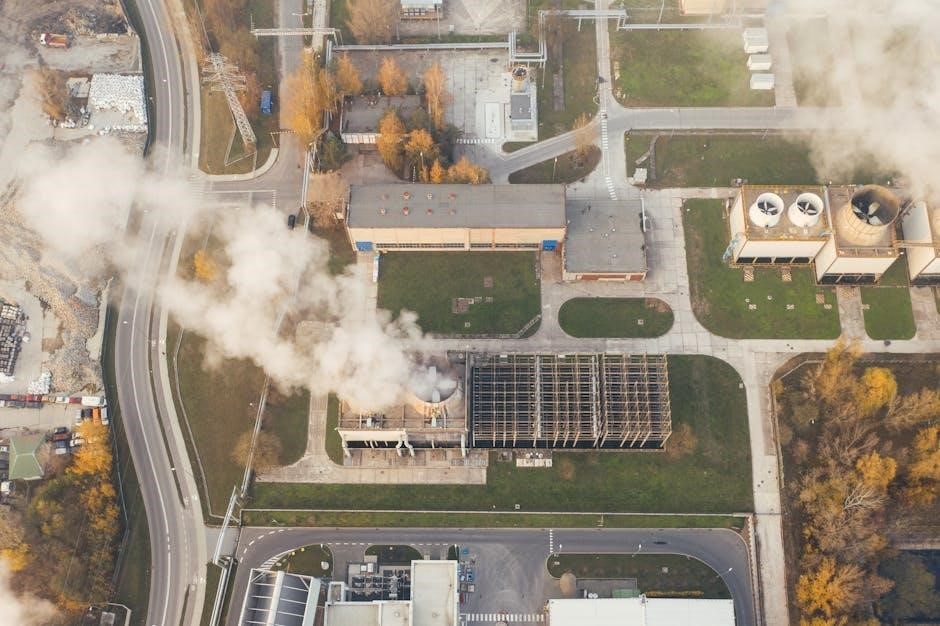Welcome to the First Alert Smoke and Carbon Monoxide Alarm manual. This guide provides essential information for installing, operating, and maintaining your alarm to ensure safety and reliability.
1.1 Importance of Smoke and Carbon Monoxide Detectors
Smoke and carbon monoxide (CO) detectors are crucial for home safety, providing early warnings for fires and CO leaks. CO, an odorless and invisible gas, can be deadly in high concentrations. Detectors like the First Alert alarm ensure timely alerts, helping prevent accidents. They are essential in every home, especially near sleeping areas. Regular maintenance and proper installation are vital for reliability. These devices comply with safety standards, offering peace of mind and protecting lives. Always follow the manual for installation and testing to ensure optimal performance and safety.
1.2 Overview of the First Alert Smoke and Carbon Monoxide Alarm
The First Alert Smoke and Carbon Monoxide Alarm is a dual-sensor device designed to detect both smoke and CO, offering comprehensive home protection. It operates on a 9V battery, ensuring continuous monitoring even during power outages. The alarm features a loud siren to alert occupants and includes a silencing feature for non-emergency situations. With a user-friendly design, it integrates easily into any home. The device meets UL standards and is compatible with smart systems for remote monitoring. Regular maintenance, such as battery replacement and cleaning, is essential for optimal performance. This alarm is a reliable choice for safeguarding against fire and CO threats.
1.3 Purpose of the Manual
This manual serves as a comprehensive guide for the First Alert Smoke and Carbon Monoxide Alarm, providing detailed instructions for installation, operation, and maintenance. It ensures users understand safety features, troubleshooting, and compliance with regulations. The manual helps maximize the device’s effectiveness and longevity, ensuring home safety. By following the guidelines, users can prevent hazards and respond appropriately during emergencies. This resource is essential for both initial setup and ongoing use, offering clear, step-by-step information to guarantee optimal performance and reliability of the alarm system.

System Components and Parts
The First Alert Smoke and Carbon Monoxide Alarm includes a mounting bracket, battery drawer, 9V battery, and user manual for installation and maintenance guidance.
2.1 Parts of the Smoke and Carbon Monoxide Alarm
The First Alert Smoke and Carbon Monoxide Alarm comprises essential components designed for optimal functionality. These include a mounting bracket for secure installation, a battery drawer that holds a 9V battery, ensuring continuous power, and a user-friendly design that simplifies maintenance. The alarm features sensors for detecting both smoke and carbon monoxide, providing dual protection for your home. Additionally, the included user manual offers detailed instructions for installation, operation, and troubleshooting. Each part is crafted to meet safety standards, ensuring reliability and efficiency in emergency situations. Understanding these components is crucial for maximizing the alarm’s performance and safeguarding your household.
2.2 Mounting Bracket and Battery Installation
The mounting bracket ensures secure installation of the First Alert Smoke and Carbon Monoxide Alarm. To install, attach the bracket to the ceiling or wall using the provided screws, ensuring it is level and firmly fixed. Next, insert a 9V battery into the battery drawer, located on the back of the alarm. Align the drawer with the unit and click it into place. Proper installation guarantees the alarm functions correctly, providing reliable protection. Always follow the manufacturer’s instructions for correct placement and battery installation to maintain optimal performance and safety features. This step is crucial for ensuring your home is protected from potential threats.
2.3 Battery Drawer and 9V Battery Requirements
The First Alert Smoke and Carbon Monoxide Alarm features a convenient battery drawer located on the back of the unit. To access it, slide the drawer open and insert a fresh 9V battery, ensuring the terminals align correctly. The battery powers the alarm in non-hardwired installations and provides backup power in hardwired models. Use only high-quality 9V alkaline batteries for optimal performance. Avoid mixing old and new batteries, as this can reduce reliability. The battery drawer is designed for easy replacement, allowing you to maintain the alarm’s functionality without tools. Proper battery installation ensures continuous monitoring and reliable alerts for smoke and carbon monoxide detection.

Installation Guidelines
Proper installation is crucial for optimal performance. Choose locations on ceilings or walls, ensuring alarms are at least 10 feet from fuel-burning appliances. Test post-installation.
3.1 Choosing the Right Location for Installation
Selecting the correct location for your First Alert Smoke and Carbon Monoxide Alarm is critical for effective detection. Install alarms on every level of your home, inside or outside sleeping areas. For peaked, gabled, or cathedral ceilings, place the alarm within 3 feet of the peak, measured horizontally. Avoid areas near windows, doors, or ducts to prevent drafts from interfering with sensor accuracy. Keep alarms at least 10 feet away from fuel-burning appliances like furnaces or water heaters to minimize false alarms. Ensure proper spacing and placement to comply with safety standards and optimize protection for your household.
3.2 Mounting the Alarm on Different Types of Ceilings
Mounting the First Alert Smoke and Carbon Monoxide Alarm varies depending on ceiling type. For flat ceilings, attach the mounting bracket to a sturdy section, ensuring the alarm is centered in the room. On peaked, gabled, or cathedral ceilings, install the alarm within 3 feet of the peak, measured horizontally. Use the provided mounting bracket and screws to secure the unit firmly. For vaulted or sloped ceilings, always follow the manufacturer’s guidelines to ensure proper placement and stability. Avoid installing near vents or fans to prevent interference with sensor performance. Ensure the alarm is level and securely fastened to guarantee accurate detection and reliability.
3.3 Ensuring Proper Spacing from Fuel-Burning Appliances
To ensure optimal performance, the First Alert Smoke and Carbon Monoxide Alarm must be installed at least 4.6 meters away from fuel-burning appliances like furnaces, water heaters, or fireplaces. This distance helps prevent false alarms caused by combustion byproducts. Avoid placing the alarm near vents, grills, or drafty areas where exhaust gases might interfere with its sensors. Additionally, never install the alarm in garages, kitchens, or near generators, as these areas may expose the sensor to high levels of CO or smoke. Always comply with local fire codes and manufacturer guidelines for placement. Proper spacing ensures accurate detection and reduces nuisance tripping. Test the alarm after installation to confirm functionality.

Maintenance and Upkeep
Regularly clean the alarm to ensure proper function. Replace the 9V battery annually or when the low-battery warning sounds. Test the alarm monthly to confirm it works correctly.
4.1 Cleaning the Alarm Regularly
Regular cleaning is crucial for maintaining the efficiency of your First Alert Smoke and Carbon Monoxide Alarm. Use a soft cloth or vacuum cleaner to gently remove dust, dirt, or insects from the exterior and interior of the alarm. Avoid using chemicals, as they may damage the sensor. Clean the grill and openings to ensure proper airflow. For models with a removable cover, take it off and wipe it with a dry cloth. Cleaning should be done at least once a month or whenever the alarm chirps due to dust interference. Failure to clean regularly may result in false alarms or reduced sensitivity.
4.2 Replacing the Battery
The First Alert Smoke and Carbon Monoxide Alarm requires a 9-volt battery for operation. To replace the battery, locate the battery drawer, which is typically on the back or side of the unit. Open the drawer and remove the old battery, then insert a new 9-volt battery, ensuring the terminals align correctly. Close the drawer securely. Avoid using mixed or old batteries, as this may cause malfunction. Regular battery replacement is essential to maintain the alarm’s functionality. If the alarm chirps to indicate a low battery, replace it promptly to ensure continuous protection. Always use the recommended battery type for optimal performance.
4.3 Testing the Alarm Functionality
To ensure your First Alert Smoke and Carbon Monoxide Alarm is functioning correctly, perform a test monthly. Locate the test button, typically on the front or top of the unit. Press and hold it until a loud, clear tone sounds, indicating the alarm is working. For dual-sensor models, this test verifies both smoke and carbon monoxide detection. If the alarm does not sound, check for obstructions or dirt, clean if necessary, and try again. If it still fails, replace the battery or the unit. Regular testing is crucial for maintaining your safety and ensuring the alarm responds to potential threats effectively. Always follow the manufacturer’s instructions for accurate results.

Understanding the Alerts and Signals
The First Alert Alarm emits distinct beeps for smoke or carbon monoxide detection, with a red light flashing during alerts. Understand these signals to respond appropriately in emergencies.
5.1 Different Types of Alarms and Their Meanings
The First Alert Smoke and Carbon Monoxide Alarm produces distinct audible and visual signals to indicate different conditions. A smoke alert is signaled by three consecutive beeps, while a carbon monoxide alert is indicated by four consecutive beeps. A single chirp every 30 seconds signifies a low battery. The red light flashes during smoke or CO detection, providing a visual warning. Understanding these signals helps you respond appropriately to emergencies, ensuring the safety of you and your household. Familiarize yourself with these alerts to act quickly and effectively in critical situations.
5.2 Responding to Smoke and Carbon Monoxide Alerts
- When the smoke or CO alarm sounds, stay calm and immediately evacuate the premises.
- Call 911 or your local emergency number from a safe location.
- Do not re-enter the building until authorities confirm it is safe.
- If CO exposure is suspected, check for symptoms like dizziness or nausea and seek medical attention if necessary.
- Only silence the alarm after ensuring the danger has passed and the area is ventilated.
Always prioritize safety and follow evacuation plans to protect yourself and others from potential harm.
5.3 Silencing the Alarm in Non-Emergency Situations
To silence the alarm during a non-emergency, such as cooking fumes triggering it, press and hold the Test/Silence button until the alarm stops. Ensure the area is well-ventilated to clear any lingering smoke or fumes. Never disable the alarm permanently, as this compromises safety. If the alarm repeatedly triggers without cause, check for dust or debris and clean the unit as described in the manual. If issues persist, consider replacing the battery or the alarm itself. Always verify that no real danger exists before silencing the alarm.

Troubleshooting Common Issues
Identify and resolve common problems with your First Alert Smoke and Carbon Monoxide Alarm, such as false alarms or connectivity issues, by consulting the troubleshooting section.
6.1 Resolving Battery-Related Problems
If your First Alert Smoke and Carbon Monoxide Alarm is experiencing battery-related issues, such as low battery chirps or failure to turn on, start by checking the battery drawer. Ensure it is fully closed and securely locked. Replace the 9V battery with a fresh one, making sure it is installed correctly. If the issue persists, clean the battery terminals with a soft cloth to remove any corrosion. For models with a battery backup, ensure the AC power is functioning properly. If the alarm still does not work, refer to the troubleshooting guide or contact customer support for assistance. Always use the recommended battery type for optimal performance.
6.2 Addressing False Alarms and Nuisance Tripping
If your First Alert Smoke and Carbon Monoxide Alarm is triggering false alarms, start by cleaning the unit to remove dust or debris. Use a soft brush or vacuum cleaner to gently clear the sensor. Ensure the alarm is not installed near cooking appliances, bathrooms, or areas prone to steam, as moisture can cause false activations. Check for proper installation and spacing from fuel-burning appliances, as outlined in the manual. If the issue persists, replace the battery with a fresh 9V one. Test the alarm after cleaning and adjusting its location to confirm it operates correctly. Regular maintenance can help minimize nuisance tripping and ensure reliable performance.
6.3 Fixing Connectivity Issues in Smart Models
To resolve connectivity issues with your smart First Alert Smoke and Carbon Monoxide Alarm, start by power cycling the device. Turn it off, wait 30 seconds, and turn it back on. Ensure your Wi-Fi network is stable and check if other smart devices are connected. Verify that the alarm is compatible with your smart home system, such as Google Home or HomeKit. Open the First Alert app, confirm your account is logged in, and ensure the app is updated to the latest version. If issues persist, reset the alarm by removing and reinstalling the battery, then reconnect it through the app. If problems remain, consult the manual or contact customer support for further assistance.

Safety Tips and Best Practices
Understand carbon monoxide poisoning symptoms, such as dizziness or nausea, and create an emergency escape plan. Ensure proper ventilation and maintain fuel-burning appliances to prevent CO leaks.
7.1 Understanding Carbon Monoxide Poisoning Symptoms
Carbon monoxide poisoning can cause symptoms like headache, dizziness, nausea, and fatigue. Severe exposure may lead to confusion, vomiting, or even loss of consciousness. Recognizing these signs is crucial, as CO is odorless and invisible, making it difficult to detect without an alarm. If you or a family member experiences these symptoms, evacuate the premises immediately and seek fresh air. Do not delay, as prolonged exposure can be fatal. Always remember, a functioning carbon monoxide alarm is your first line of defense against this silent threat. Act quickly to ensure everyone’s safety and call emergency services if needed.
7.2 Creating an Emergency Escape Plan
Developing a clear emergency escape plan is vital for ensuring safety in case of a smoke or carbon monoxide alarm. Identify at least two escape routes from each room and designate a safe meeting spot outside the home. Practice drills regularly with all household members to familiarize everyone with the plan. Ensure windows and doors are accessible and free from obstructions. Plan for special needs, such as assisting young children or elderly family members. Stay low while escaping to avoid inhaling toxic fumes. Never re-enter a hazardous area once safely outside. Preparation is key to saving lives in an emergency.
7.3 Preventing Carbon Monoxide Leaks in the Home
Preventing carbon monoxide leaks is crucial for home safety. Ensure proper installation and maintenance of fuel-burning appliances like furnaces, water heaters, and stoves. Hire a qualified technician to inspect these devices annually. Never use generators or grills indoors, as they emit deadly CO. Keep vents and chimneys clear of debris to ensure proper ventilation. Install CO alarms to detect leaks early. Avoid running cars in attached garages, even with the door open. Check for cracks in heat exchangers and ensure appliances are working correctly. By following these steps, you can significantly reduce the risk of carbon monoxide leaks in your home.

Compliance and Regulatory Standards
The First Alert Smoke and Carbon Monoxide Alarm meets UL 217 and UL 207 standards, ensuring reliability and compliance with safety regulations. It adheres to local fire codes and is designed to provide accurate detection and alerts for smoke and CO levels, safeguarding your home and family with certified performance. Regular updates and adherence to industry standards make it a trusted choice for home safety systems.
8.1 UL Certification and Compliance
The First Alert Smoke and Carbon Monoxide Alarm is UL 217 and UL 207 certified, ensuring it meets rigorous safety and performance standards. UL certification confirms the alarm detects smoke and carbon monoxide accurately, providing reliable protection. This compliance guarantees the device operates efficiently under various conditions and adheres to industry regulations. The UL mark signifies trust, as it is awarded only after passing extensive testing by Underwriters Laboratories. By choosing a UL-certified alarm, you ensure your home meets local fire and safety codes, offering peace of mind and enhanced protection for your family.
8.2 Meeting Local Fire and Safety Codes
Ensure your First Alert Smoke and Carbon Monoxide Alarm complies with local fire and safety codes, as requirements vary by jurisdiction. Install alarms in locations specified by local regulations, such as near sleeping areas or on every level of your home. Some areas may require hardwired interconnected alarms, while others permit battery-operated units. Always verify installation standards with your local fire department or building authority to ensure compliance. Proper placement and operation of the alarm are critical for meeting safety codes and providing reliable protection. Compliance ensures your system functions optimally, offering early detection and precious time to escape in emergencies.
8.4 Warranty and Liability Information
Your First Alert Smoke and Carbon Monoxide Alarm is backed by a limited warranty covering defects in materials and workmanship for a specified period. Refer to the warranty section in the manual for details. The manufacturer is not liable for damages resulting from misuse, negligence, or failure to follow installation or maintenance instructions. Liability is limited to product repair or replacement at the manufacturer’s discretion. Proper use and adherence to guidelines are essential to ensure warranty validity and optimal performance of the alarm. Always review the warranty terms to understand your rights and the manufacturer’s obligations.

Smart Features and Connectivity
The First Alert Smoke and Carbon Monoxide Alarm integrates with smart home systems, enabling voice control and remote notifications. This feature enhances safety and convenience for users.
9.1 Integration with Smart Home Systems
The First Alert Smoke and Carbon Monoxide Alarm seamlessly integrates with popular smart home systems, such as Google Home and Apple HomeKit. This connectivity allows users to receive real-time notifications and voice alerts through their smart devices. The alarm can be controlled and monitored remotely, providing an added layer of safety and convenience. Additionally, it works with other smart devices to create a comprehensive home safety network. For setup, follow the instructions in the user manual or visit the First Alert website for detailed guidance. This feature ensures you stay informed and in control, no matter where you are.
9.2 Remote Monitoring and Alerts
The First Alert Smoke and Carbon Monoxide Alarm offers remote monitoring and alerts, enabling users to stay informed about their home’s safety from anywhere. Through the compatible app, you can receive notifications on your smartphone or tablet when an alarm is triggered. This feature provides peace of mind, especially when you’re away from home. Remote alerts include notifications for smoke, carbon monoxide detection, and low battery warnings. Ensure your device is connected to a stable internet connection and follow the manual’s setup instructions to activate this feature. Remote monitoring ensures you can respond quickly to potential threats, even when you’re not physically present.
9.3 Compatibility with Other Smart Devices
The First Alert Smoke and Carbon Monoxide Alarm integrates seamlessly with various smart home systems, enhancing your home’s safety and convenience. It is compatible with Google Home, allowing voice control and notifications through the Google Home app. Additionally, select models like the OneLink Safe & Sound are Apple HomeKit-enabled, offering advanced integration with iOS devices. This compatibility ensures that you can monitor your home’s safety and receive alerts directly through your preferred smart home platform. The alarm also works with other smart devices, creating a unified system for whole-home protection. Always check compatibility with your specific smart home ecosystem for optimal performance.

User Manual and Additional Resources
Access the full user manual for detailed instructions and troubleshooting guides. Register your product and find online support for assistance with installation and maintenance.
10.1 Accessing the Full User Manual
To access the full user manual for the First Alert Smoke and Carbon Monoxide Alarm, visit the official First Alert website. The manual is included in the product packaging and can also be downloaded online. It provides detailed instructions for installation, operation, and troubleshooting. The manual covers key topics such as battery installation, alarm maintenance, and understanding alerts. For smart models, it includes guidance on connectivity and integration with smart home systems. Additional resources like FAQs and troubleshooting guides are also available online. Ensure to refer to the manual for specific model instructions and safety precautions. Downloading the manual ensures you have comprehensive guidance at your fingertips.
10.2 Online Support and Customer Service
First Alert offers comprehensive online support and customer service to assist with any questions or issues regarding the Smoke and Carbon Monoxide Alarm. Visit their official website to access a wealth of resources, including troubleshooting guides, FAQs, and downloadable manuals. For direct assistance, contact their customer service team via phone or email. The website also provides links to product registration, warranty information, and repair services. Online support ensures you can resolve issues quickly and efficiently, maintaining the safety and functionality of your alarm. Utilize these resources to address concerns and stay informed about product updates and safety tips.
10.3 Troubleshooting Guides and FAQs
First Alert provides detailed troubleshooting guides and FAQs to help resolve common issues with the Smoke and Carbon Monoxide Alarm. These resources address concerns such as battery-related problems, false alarms, and connectivity issues in smart models. The guides offer step-by-step solutions for scenarios like error lights, chirping sounds, and sensor malfunctions. FAQs cover topics like alarm installation, maintenance, and understanding different alert signals. By referring to these materials, users can quickly identify and fix issues, ensuring their alarm operates effectively. Troubleshooting guides and FAQs are available online, making it easy to find solutions and maintain optimal safety in your home.

